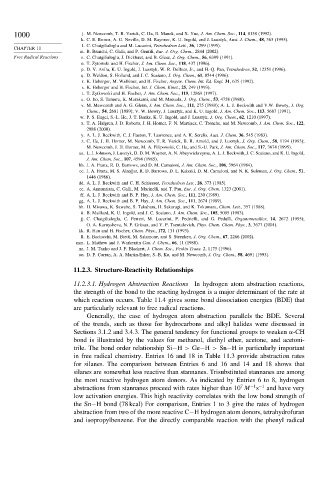Page 1016 - Advanced Organic Chemistry Part A - Structure and Mechanisms, 5th ed (2007) - Carey _ Sundberg
P. 1016
1000 j. M. Newcomb, T. R. Varick, C. Ha, B. Manek, and X. Yue, J. Am. Chem. Soc., 114, 8158 (1992).
k. C. E. Brown, A. G. Neville, D. M. Raynner, K. U. Ingold, and J. Lusztyk, Aust. J. Chem., 48, 363 (1995).
l. C. Chatgilialoglu and M. Lucarini, Tetrahedron Lett., 36, 1299 (1995).
CHAPTER 11
m. B. Branchi, C. Galli, and P. Gentili, Eur. J. Org. Chem., 2844 (2002).
Free Radical Reactions n. C. Chatgilialoglu, J. Dickhaut, and B. Giese, J. Org. Chem., 56, 6399 (1991).
o. T. Zytowski and H. Fischer, J. Am. Chem. Soc., 118, 437 (1996).
p. D. V. Avila, K. U. Ingold, J. Lusztyk, W. R. Dolbier, Jr., and H.-Q. Pan, Tetrahedron, 52, 12351 (1996).
q. D. Weldon, S. Holland, and J. C. Scaiano, J. Org. Chem., 61, 8544 (1996).
r. K. Heberger, M. Walbiner, and H. Fischer, Angew. Chem. Int. Ed. Engl. 31, 635 (1992).
s. K. Heberger and H. Fischer, Int. J. Chem. Kinet., 25, 249 (1993).
t. T. Zytkowski and H. Fischer, J. Am. Chem. Soc., 119, 12869 (1997).
u. O. Ito, S. Tamura, K. Murakami, and M. Matsuda, J. Org. Chem., 53, 4758 (1988).
v. M. Mewcomb and A. G. Glenn, J. Am. Chem. Soc., 111, 275 (1989); A. L. J. Beckwith and V.W. Bowry, J. Org.
Chem., 54, 2681 (1989); V. W. Bowry, J. Lusztyk, and K. U. Ingold, J. Am. Chem. Soc., 113, 5687 (1991).
w. P. S. Engel, S.-L. He, J. T. Banks, K. U. Ingold, and J. Lusztyk, J. Org. Chem.,62, 1210 (1997).
x. T. A. Halgren, J. D. Roberts, J. H. Horner, F. N. Martinez, C. Tronche, and M. Newcomb, J. Am. Chem. Soc., 122,
2988 (2000).
y. A. L. J. Beckwith, C. J. Easton, T. Lawrence, and A. K. Serelis, Aust. J. Chem. 36, 545 (1983).
z. C. Ha, J. H. Horner, M. Newcomb, T. R. Varick, B. R. Arnold, and J. Lusztyk, J. Org. Chem., 58, 1194 (1993);
M. Newcomb, J. H. Horner, M. A. Filipowski, C. Ha, and S.-U. Park, J. Am. Chem. Soc., 117, 3674 (1995).
aa. L. J. Johnson, J. Lusztyk, D. D. M. Wayner, A. N. Abeywickreyma, A. L. J. Beckwith, J. C. Scaiano, and K. U. Ingold,
J. Am. Chem. Soc., 107, 4594 (1985).
bb. J. A. Franz, R. D. Barrows, and D. M. Camaioni, J. Am. Chem. Soc., 106, 3964 (1984).
cc. J. A. Franz, M. S. Alnajjar, R. D. Barrows, D. L. Kaisaki, D. M. Camaioni, and N. K. Suleman, J. Org. Chem., 51,
1446 (1986).
dd. A. L. J. Beckwith and C. H. Schiesser, Tetrahedron Lett., 26, 373 (1985).
ee. A. Annunziata, C. Galli, M. Marinelli, and T. Pau, Eur. J. Org. Chem. 1323 (2001).
ff. A. L. J. Beckwith and B. P. Hay, J. Am. Chem. Soc., 111, 230 (1989).
gg. A. L. J. Beckwith and B. P. Hay, J. Am. Chem. Soc., 111, 2674 (1989).
hh. H. Misawa, K. Sawabe, S. Takahara, H. Sakuragi, and K. Tokumaru, Chem. Lett., 357 (1988).
ii. B. Maillard, K. U. Ingold, and J. C. Scaiano, J. Am. Chem. Soc., 105, 5095 (1983).
jj. C. Chatgilialoglu, C. Ferreri, M. Lucarini, P. Pedrielli, and G. Pedulli, Organometallics, 14, 2672 (1995);
O. A. Kurnysheva, N. P. Gritsan, and Y. P. Tsentalovich, Phys. Chem. Chem. Phys., 3, 3677 (2001).
kk. R. Han and H. Fischer, Chem. Phys., 172, 131 (1993).
ll. E. Baciocchi, M. Bietti, M. Salamone, and S. Steenken, J. Org. Chem., 67, 2266 (2002).
mm. L. Mathew and J. Warkentin Can. J. Chem., 66, 11 (1988).
nn. J. M. Tanko and J. F. Blackert, J. Chem. Soc., Perkin Trans. 2, 1175 (1996).
oo. D. P. Curran, A. A. Martin-Esker, S.-B, Ko, and M. Newcomb, J. Org. Chem., 58, 4691 (1993).
11.2.3. Structure-Reactivity Relationships
11.2.3.1. Hydrogen Abstraction Reactions In hydrogen atom abstraction reactions,
the strength of the bond to the reacting hydrogen is a major determinant of the rate at
which reaction occurs. Table 11.4 gives some bond dissociation energies (BDE) that
are particularly relevant to free radical reactions.
Generally, the ease of hydrogen atom abstraction parallels the BDE. Several
of the trends, such as those for hydrocarbons and alkyl halides were discussed in
Sections 3.1.2 and 3.4.3. The general tendency for functional groups to weaken -CH
bond is illustrated by the values for methanol, diethyl ether, acetone, and acetoni-
trile. The bond order relationship Si−H > Ge−H > Sn−H is particularly important
in free radical chemistry. Entries 16 and 18 in Table 11.3 provide abstraction rates
for silanes. The comparison between Entries 6 and 16 and 14 and 18 shows that
silanes are somewhat less reactive than stannanes. Trisubstituted stannanes are among
the most reactive hydrogen atom donors. As indicated by Entries 6 to 8, hydrogen
7
−1 −1
abstractions from stannanes proceed with rates higher than 10 M s and have very
low activation energies. This high reactivity correlates with the low bond strength of
the Sn−H bond (78 kcal) For comparison, Entries 1 to 3 give the rates of hydrogen
abstraction from two of the more reactive C−H hydrogen atom donors, tetrahydrofuran
and isopropylbenzene. For the directly comparable reaction with the phenyl radical

